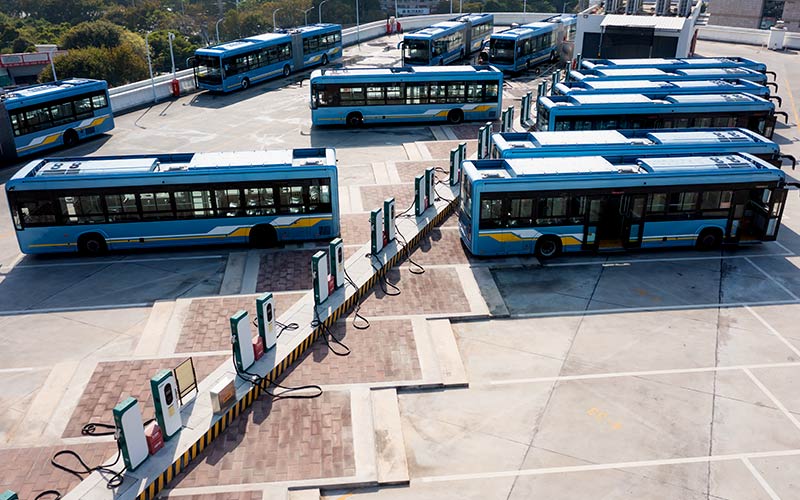Insights
- Reliability is the top criteria among EV drivers for choice of a charging station in China and the US, surpassing price, charging time, and ease of use.
- CPOs or Charging Point Operators establish and run stations, while e-Mobility Service Providers or EMSPs empower EV drivers to access real-time station availability and charging data records.
- EMSPs have become critical to reliable charging station operations and timely data to increase their availability.
- A cloud-based setup is crucial for reliable data handling and calculations to ensure charging station uptime.
- In today’s hyperconnected world, an always-on service desk is essential, and bots are efficient to do that with conversational AI.
- EMSPs serve as the final link in the mobility electrification chain, connecting vehicle manufacturers with drivers.
Electric vehicles (EVs) form a dynamic ecosystem, where consumers, infrastructure providers, and service providers extend the manufacturer’s impact to collaborate for large-scale EV adoption. Our earlier article explained diverse roles in the EV ecosystem, particularly charging point operators (CPOs) and e-mobility service providers (EMSPs). CPOs establish and run stations, while EMSPs empower EV drivers to access real-time station availability and charging data records (CDRs).
Charging stations and their challenge
A recent Infosys study emphasized price and range concerns as the biggest roadblocks to EV adoption. As battery prices continue to fall, charging stations become crucial to ease range anxiety and boost EV adoption. The World Economic Forum projects investments of $500 billion for 290 million additional charging points globally by 2040.
Charging stations in the US must triple from the current 56,000 to 168,000 by 2030, according to another estimate. The US government announced a $5 billion investment for 500,000 new charging stations in the next few years, more than three times the 145,000 gasoline fuel stations today. Yet even this investment won’t be enough. The larger financial and operational hurdle looms in charging station maintenance.
J.D. Power’s recent findings on US charging stations are worrisome. Nonfunctional stations increased from 15% in 2021 to 21% in 2023. Similar challenges persist globally due to issues like parts breakage and theft, faulty payment gateways, and maintenance lapses. BCG reported reliability as the top criteria among EV drivers for choice of a charging station in China and the US, surpassing price, charging time, and ease of use. EMSPs have become critical to reliable station operations and timely data to increase availability.
EMSPs have become critical to reliable electric vehicle charging station operation and timely data sharing.
CPOs and EMSPs in action
CPOs provide the physical infrastructure that EV drivers require to charge their vehicles. They install and maintain charging stations in public parking and gas stations, garages, shopping malls, and workplaces. EMSPs streamline the EV driver’s experience to locate and use charging stations through a variety of services:
- Mobile app to find stations and pay for charging sessions
- Roaming agreements to use other EMSP charging stations
- Subscription plans for discounted charging rates
- Flexible session payment methods
CPOs and EMSPs work together to increase e-mobility convenience. EV demand becomes symbiotic, driving growth for both roles.
Figure 1. Symbiotic EMSP and CPO roles across the EV ecosystem
Source: Infosys
EMSPs act as a billing intermediary between CPOs and EV drivers. They collect payments from EV drivers for charging sessions and remit to CPOs.
Data collection for billing and invoicing
EMSPs collect and aggregate CDRs from CPOs, including charging session details, energy consumption, renewable energy usage, and charging station identifiers. EMSPs establish secure data-sharing agreements with CPOs to access necessary data for invoicing and billing. In the US, President Biden’s proposal for EV charging networks mandates a minimum uptime of 97% for the hardware and software in the stations. Likewise, the UK government mandates 99% uptime for public charging stations. Hence, a cloud-based setup is crucial for reliable data handling and calculations. Cloud-based computing and storage become a central, standardized repository to pool in critical data from stations with diverse infrastructure.
EMSPs determine charging costs using tariff rates, which hinge on factors like energy consumption, renewables used, and charging day and time. They should offer fair and transparent pricing models that cater to diverse customer needs. Dynamic pricing incentivizes EV drivers for off-peak usage and eco-friendly charging.
After charging calculations, EMSPs generate periodic (usually monthly) invoices that detail charging sessions, energy consumed, and price. They leverage online platforms and mobile apps to deliver invoices and a hassle-free billing and payment experience.
EMSPs also facilitate roaming services and cross-border charging via strategic partnerships and agreements with international CPOs, which means EV drivers can travel away from home with confidence. By seamlessly handling CPO charging data in neighboring countries, EMSPs create a consistent and transparent billing process regardless of the driver’s location, using country-specific tariffs and VAT expenses incurred in local currency. They also settle tax obligations for roaming charges across countries in local currencies.
The role of a charging station configurator
Diversity in technologies, grids, chargers, connectors, methods, and limited standardization complicate charging station setup. Configurators improve station setup with accurate cost and price estimates.
A charging station setup comprises point count, port mix, charging level (1 to 4 based on speed), power source (renewable vs. traditional, grid vs. local), and pricing. Configurator processes optimize charging station configuration based on these factors for the lowest cost.
CSCP addresses interoperability challenges through a service platform approach, where it analyzes core requirements. It uses algorithms to match chargers to specific use cases that encompass hardware and software elements. CSCP offers libraries to precisely estimate cost and suggests a bill-of-material for cost-effective stations. A cloud-native, microservices-based architecture for the configurator enables modularity, elasticity, and remote monitoring for the platform. Updates to submodules can be rolled out without impacting the overall solution. Charging station configurators aid both EMSPs and CPOs.
CPOs efficiently plan and deploy charging infrastructure using location specifics, while EMSPs identify expansion potential based on demography and other factors to enhance network and services. EMSPs and CPOs collaboratively leverage charging station configurators to accelerate EV adoption and improve the overall EV landscape.
Figure 2. Charging station configurator process
Source: Infosys

AI use cases for e-mobility
EMSPs serve as the final link in the mobility electrification chain, connecting vehicle manufacturers with drivers. They provide charging as a service via a user app and user queries. Chatbot-driver conversational AI is efficient for queries like nearest charging station, its condition, and other charging clarifications. Gartner predicts chatbots to become the primary customer service channel for a quarter of organizations globally by 2027.
Charging station bots trained with operating manuals and historical customer queries provide 24x7 customer service. They learn from each interaction and need human intervention for exceptions. In today’s hyperconnected world, an always-on service desk is essential, and bots are efficient to do that.
Other AI use cases for EMSPs
- Optimized charging operations: AI-driven demand forecasts predict charging needs to avoid surprises for power utilities. They offer route optimization for efficient charging, reduce costs and improve fleet management.
- Personalized customer experience: Customer engagement is through AI-driven analysis of behavior for customer segmentation to offer tailored services, targeted marketing campaigns, and personalized billing plans.
- Smart maintenance and anomaly detection: Predictive maintenance and anomaly detection are powered by AI to prevent charging station downtime, ensure smooth operations, and identify irregular charging events promptly.
Case studies
EMSPs empower EV drivers with streamlined charging experiences, while CPOs merge convenience and sustainability. Below is a list of select EMSPs and CPOs:
EMSPs:
- Global player EVBox provides EV charging solutions that include a mobile app, roaming agreements, and subscription plans. They have more than 220,000 charging points across 60 countries.
- Hailing from the Netherlands, NewMotion offers EV charging solutions, with roaming agreements for diverse EMSP use. They have more than 120,000 charging points in over 25 countries.
- ChargePoint, a US heavyweight, offers a variety of charging solutions, including a mobile app, roaming agreements, and subscription plans. They have over 100,000 charging points across 14 countries.
CPOs:
- BP Pulse leads the UK's EV charging network, with over 9,000 public stations and 3,000 ultra-fast charging points.
- IONITY spans Europe, with more than 400 high-power charging points in 24 countries, including the UK.
- UK’s Gridserve operates over 100 ultra-fast charging stations, with plans for more than 1,000 by 2023’s close.
Recommendations
The EV landscape requires collaboration among stakeholders beyond vehicle manufacturers. CPOs manage the infrastructure, while EMSPs empower drivers with station access and digital services. As investment in charging stations grows, their maintenance and reliability emerge as significant challenges. Increases in nonfunctional stations amplify range anxiety and hinder EV adoption. EMSPs become vital for transparent station operations and timely information of availability.
EMSPs and CPOs drive e-mobility toward sustainability. Their collaboration fuels charging infrastructure growth, enhances user experience, and supports global EV adoption.
We recommend the following steps to realize the benefits of the EV industry:
- Invest in charging infrastructure maintenance and real-time monitoring. Regular inspection, maintenance, and charging station upgrades improve their reliability and availability. Real-time monitoring identifies and resolves issues promptly and creates a consistent charging experience. CPOs need to develop scheduled maintenance routines that include regular inspections, component replacements, and software updates to prevent potential failures. Clear SLAs between CPOs and EMSPs should be defined to ensure that downtime is minimized and disruptions are promptly addressed.
- Increase EMSP-CPO collaboration. EMSPs assist CPOs to optimize station locations and identify high EV adoption areas. CPOs support EMSPs in network maintenance and expansion. Strong partnerships between EMSPs and CPOs create a seamless charging landscape. Anonymized charging data shared with CPOs helps them strategically place new stations in high-demand areas, to reduce congestion and improve access.
- Promote standardization and interoperability. Unified charging protocols and connectors ease charging station use, regardless of EMSP or CPO operating them. Standardization also simplifies the integration of charging station configurators and enables accurate cost estimates and optimal charging infrastructure deployments. Establishment of universal payment gateways allows users to seamlessly pay for charging across different networks and reduced friction for EV drivers.
- Incentivize station deployments and upgrades. Incentives, tax breaks, and subsidies from governments and regulatory bodies boost investments in charging stations. Encourage renewable energy use for sustainable charging practices. Collaboration with local governments streamlines the permit process for charging station installations, reducing bureaucratic delays.
In the digital age, information flow for critical assets is as important as the asset itself. EMSPs plug the gap of timely and reliable information flow for EV charging stations. This provides leaders untapped business opportunities in a growing market.







